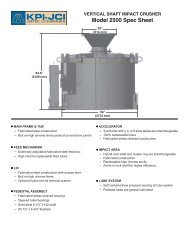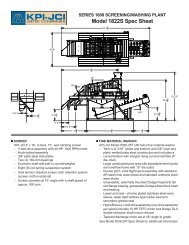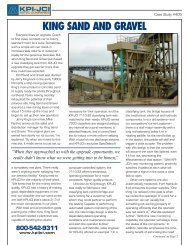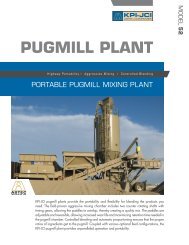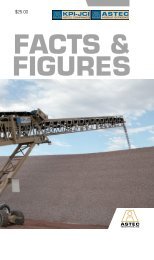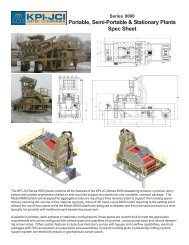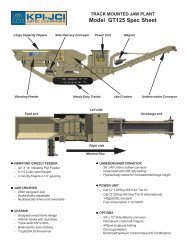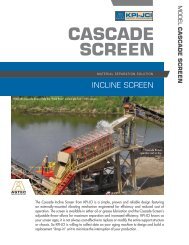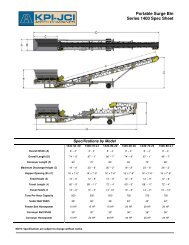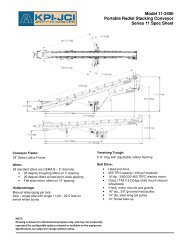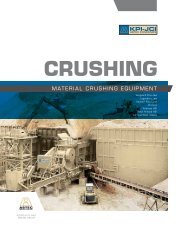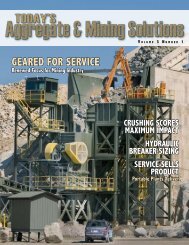paver's pugmill performance is the key to bringing home ... - KPI-JCI
paver's pugmill performance is the key to bringing home ... - KPI-JCI
paver's pugmill performance is the key to bringing home ... - KPI-JCI
Create successful ePaper yourself
Turn your PDF publications into a flip-book with our unique Google optimized e-Paper software.
The Kolberg Model 52S features a continuous flow mix and <strong>the</strong> ability <strong>to</strong> vary retention<br />
time <strong>to</strong> meet changing job requirements.<br />
open-graded bases,” says Wittwer. “It’s<br />
designed <strong>to</strong> handle drier materials at<br />
higher capacities while maintaining <strong>the</strong><br />
quality of <strong>the</strong> mix.”<br />
“Before using <strong>the</strong> <strong>pugmill</strong>, we were<br />
producing base with a double drum<br />
concrete batch plant,” says Wittwer. He<br />
stresses <strong>the</strong> d<strong>is</strong>advantages of that<br />
method: “In a concrete batch plant, you<br />
get a lot of buildup in <strong>the</strong> drum when<br />
mixing drier materials and that means<br />
that at some point, you’re going <strong>to</strong> have<br />
<strong>to</strong> get in <strong>the</strong>re and jackhammer all that<br />
out. Also, in a concrete batch plant,<br />
you’re mixing an 8- <strong>to</strong> 12-yard batch at<br />
a time. With a <strong>pugmill</strong>, you have<br />
continuous flow.”<br />
Wittwer explains that <strong>the</strong> Kolberg<br />
Model 52S Pugmill comes standard<br />
with 13 and 11 cu. yd. feed hoppers,<br />
plus 36" wide variable-speed belt<br />
feeders, a 36" wide belt conveyor and a<br />
full 4' x 8' <strong>pugmill</strong> mixing chamber.<br />
For an optimum mix, <strong>the</strong> mixing<br />
chamber features high retention time,<br />
timed dual logs, and 40 paddle tips,<br />
versus conventional <strong>pugmill</strong>s with only<br />
“With <strong>the</strong> computerization,<br />
we can calibrate <strong>the</strong><br />
<strong>pugmill</strong> and certify it.”<br />
32. Wittwer comments that <strong>the</strong> 40<br />
paddle tips are adjustable, reversible<br />
and easy <strong>to</strong> replace. “That means we<br />
get a better mix while lowering our<br />
wear costs,” he says.<br />
“As <strong>the</strong> <strong>pugmill</strong> <strong>is</strong> continuously<br />
mixing, we have a hopper at <strong>the</strong><br />
d<strong>is</strong>charge end of <strong>the</strong> mixing chamber<br />
that will hold up <strong>to</strong> 5 <strong>to</strong>ns of material,”<br />
says Wittwer. “So if one truck pulls<br />
away, <strong>the</strong> next truck can immediately<br />
load from <strong>the</strong> hopper.”<br />
He adds that <strong>the</strong> <strong>pugmill</strong> <strong>is</strong> charged<br />
with two loaders, one for sand and one<br />
for aggregate. “We’re using two<br />
different types of aggregate - a coarse<br />
aggregate and a crushed s<strong>to</strong>ne,” he<br />
remarks.<br />
Wittwer Paving specified <strong>the</strong><br />
Kolberg Pugmill with cus<strong>to</strong>mized fullyprogrammable<br />
computerized controls,<br />
computerized belt scales and a drivepowered<br />
flow meter <strong>to</strong> meter <strong>the</strong><br />
cement or fly ash. Wittwer explains<br />
that <strong>the</strong> flow meters coupled with <strong>the</strong><br />
computerized belt scales makes <strong>the</strong> unit<br />
unique. “We wanted a system that<br />
would adjust itself au<strong>to</strong>matically, or<br />
“on-<strong>the</strong>-fly,” according <strong>to</strong> what material<br />
was flowing through it,” he says. “We<br />
can also program it <strong>to</strong> mix a 25- <strong>to</strong> 28-<br />
<strong>to</strong>n load, shut down as <strong>the</strong> truck comes<br />
in, <strong>the</strong>n mix ano<strong>the</strong>r load of <strong>the</strong> same<br />
<strong>to</strong>nnage.”<br />
“With <strong>the</strong> computerization, we can<br />
calibrate <strong>the</strong> <strong>pugmill</strong> and certify it,”<br />
says Wittwer, “and <strong>the</strong> belt scales give<br />
us an instantaneous reading. We don’t<br />
have <strong>to</strong> weigh each individual load. On<br />
certain conventional <strong>pugmill</strong>s, you have<br />
<strong>to</strong> weigh every load.”<br />
Today, with <strong>the</strong> need <strong>to</strong> expedite<br />
road projects, equipment such as <strong>the</strong><br />
portable <strong>pugmill</strong> <strong>is</strong> one important link<br />
<strong>to</strong>ward that goal. “The industry <strong>is</strong><br />
changing,” remarks Wittwer. “There’s a<br />
trend <strong>to</strong>ward awarding more (design<br />
and build) projects with extended<br />
warranties. In o<strong>the</strong>r words, we’re asked<br />
<strong>to</strong> handle <strong>the</strong> entire road project from<br />
design through maintenance on one<br />
contract. That demands accelerated<br />
schedules, high-quality, high-capacity<br />
production and <strong>the</strong> equipment and<br />
manpower <strong>to</strong> get <strong>the</strong> job done.”<br />
KOLBERG-PIONEER<br />
Has All The Pieces<br />
800-542-9311



